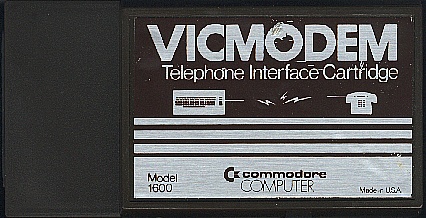VICModem
As the world of computer telecommunications grew with various on-line services and computer bulletin board systems, the VicModem (product number VIC-1600) became another popular peripheral for the Vic 20. At the time, it was the cheapest modem available for a home computer.
The modem itself plugged into the user port of the Vic 20, leaving the cartridge port free for telecommunications software cartridges or memory expansion. A red LED on the side of the modem showed you if it was active or not, and a switch on the side would set the modem to "Answer" mode or "Originate" (or call) mode.
The VICModem has the narrower RJ-9 jack on the back, not the wider RJ-11 jack for "standard" phone cables, because Commodore intended that users would disconnect the cable that went between their phone's base and the handset and plug this into the back of the modem so that they could use the phone's keypad (on tone phones) or rotary dial (on pulse phones) to dial the number they wanted to connect to. Running at up to 300 baud, one would manually dial the phone number of the service on the telephone's base and listen for the carrier signal. Once this carrier signal was heard, the user would manually detach the cord from the telephone handset and plug it into the VICmodem.
In Canada, the VICModem was shipped in a large package which included a Commodore branded rotary dial telephone.
Things were a little different in Canada where Northern Electric, the precursor to Northern Telecom, was the sole suppler of telecom equipment to Bell Canada. In other countries, where phones had detachable handsets, a narrower RJ-9 jack was used to connect a telephone's handset to its base. This was so people wouldn't be able to plug the handset directly into a wall jack. All Canadian phones avoided this problem entirely by hardwiring the handsets to the phone's base. However, this design would mean the VICModem was useless in Canada.
Commodore Canada came up with a simple solution to the problem; they would include a "special" phone with every VICModem sold there. The one problem was that Bell Canada owned the phone network in Canada and had very strict rules about what could be connected to their network. In fact, Bell Canada owned every phone in Canada and they leased them to their customers. Bell Canada agreed to the inclusion of these Commodore phones provided that they were only sold with the VICModem, complied with government regulations and were made by their subsidiary, Northern Electric. Commodore agreed and placed the order. Northern Electric made the phones (these have the Commodore name and logo printed on them) and shipped them to Commodore.
That's when things got complicated. It seems that the phones Northern Electric made were their standard issue phones -- with hardwired handsets. Worse yet, when Commodore complained that the phones wouldn't work in the intended fashion, Bell told them that they wouldn't allow phones such phones on their network anyway because of an obscure regulation that said all phones had to remain fully functional if they were connected to the network. A phone without a handset wouldn't be fully functional and as a result, was forbidden.
Commodore was forced to go back to the drawing board and they came up with the VIC-1605 adaptor switch. On one side it had an RJ-9 (male) plug to fit into the VICModem, on the other side it had two RJ-11 (female) jacks, one into which a person would plug the Commodore telephone and the other into which they plugged a cable which ran to the wall phone jack. The VIC-1605 also had a little switch to choose which device (modem or telephone) received the signal from the wall-jack. Problem solved. Commodore was sitting on a bunch of phones so they figured they might as well sell them with the VICModem and that's exactly what they did.
If Commodore had known all the Canadian telecommunication regulations they could have spared themselves a lot of time and money and gone with the 1605 plan in the first place. C'est la vie.







